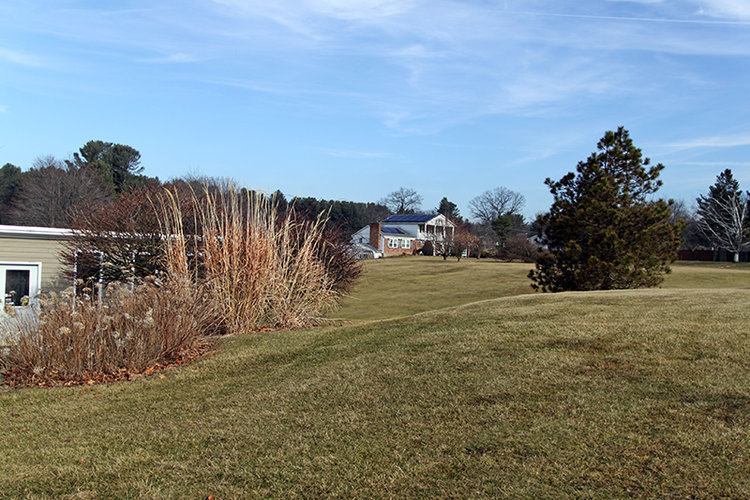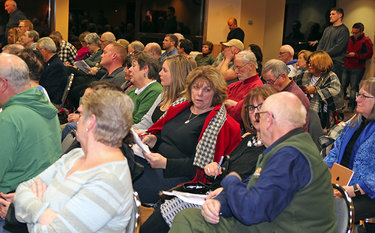Guilderland golf course to be site of senior housing
GUILDERLAND — After more than a year of controversy and changes to his original plan, Tony Carrow got the approval he needed to proceed with his plans to build senior housing on a former golf course.
Guilderland’s zoning board voted, 4 to 0, on May 15 to approve Carrow’s request for a special-use permit and area variances to build a 256-unit senior independent-living facility at the site of the former Hiawatha Trails Executive Golf Course at 6025 and 6051 State Farm Road.
This project, originally proposed as a planned-unit development a year-and-a-half ago, was the catalyst for the birth of a grassroots citizens’ group, now called the Guilderland Coalition for Responsible Growth, which is opposed to the project’s size and height.
The coalition has gone on to keep a close eye on development in the central part of the town in particular, from about Willow Street to Route 155, and throughout Guilderland and currently has about 160 members on its email list “and growing by the week, each time a new proposal comes up,” according to Frank Casey, who recently stepped down as the group’s head.
Jacob Crawford, a member of the zoning board of appeals and the chairman of the Guilderland Democratic Committee, chaired this portion of the May 15 meeting. Chairman Thomas Remmert and alternate member Stephen Albert had both recused themselves because of their connection to the developer. Carrow is chief of the Westmere Fire Department, and both Remmert and Albert are volunteer firefighters.
The board voted, 4 to 0, to grant a negative declaration under the State Environmental Quality Review Act, which means that the board determined the project would not have a significant impact on the environment and does not need in-depth review.
The project had started out as an application for a planned unit development before the town board, but an office building was dropped from the plan, which meant that only a special-use permit and variances were needed, since a senior independent-living facility is an allowed use in the residential R-40 zoning district.

Hiawatha Trails Executive Golf Course on Route 155 will become the site of a senior independent-living facility.
Two variances were granted. One allows four storeys totaling 46 feet, where two-and-a-half storeys or 35 feet is allowed. The other variance allows construction of detached garages in a side yard.
Crawford said during the meeting that it was clear from neighborhood response that many people have loved Hiawatha Trails Executive Golf Course, and he thanked the residents for their participation in and their decorum at the public hearing, calling it “a wonderful discourse among neighbors and residents of the town.” He did not specifically address any of the issues that opponents of the project had raised.
Crawford did say, “We are also aware that the number of projects in this town come to this board for an appeal under the regulations of the zoning law. So we know that, when these proposals come to us, it is not just something that should be an automatic; it is someone that is asking for a change, for their specific project, from the law as it is currently written. And that is not something we take lightly; it is something this board has weighed, and it’s the reason we’ve asked the questions we have of you and of the developer.”
Concerns remain
Casey, who has been outspoken in his concerns about the project since it was proposed, wrote in an email to The Enterprise, “Failing any effort by the town planners to preserve the parcel as green recreational infrastructure per the recommendation of the Hamlet Master Plan, the resulting proposal is not only too massive in height and scope for the small land area, its appearance, rather than transitioning from apartments to homes, will look like nothing more than yet another apartment complex on that stretch of Route 155, lacking only young people.”
The majority of the site will be dedicated to the town as green space, Crawford said, and the applicant will build a public multi-use path. Town officials hope that eventually the path will link Route 155 to Winding Brook Drive.
One of the conditions of the approval is that the applicant work to build the units in phases, Crawford told The Enterprise this week. As stated by the applicant, he said, the first phase would consist of 130 units. Carrow will then consult with the town planner and the chief building and zoning inspector on the feasibility of proceeding with the remaining phases. One condition of the approval reads, in part, “The project is not to exceed 256 units and is encouraged to develop less than the application.”
Casey told The Enterprise he is still concerned that there is no recourse to assure that the project will not become “yet another general apartment complex where it otherwise is not permitted, if the developer fails to find a sufficient number of seniors.” The zoning board did put in a reporting stipulation, Casey noted, but the Guilderland Coalition for Responsible Growth had asked for a surety bond, he said.
According to project attorney Terresa Bakner of Whiteman, Osterman & Hanna, developer Carrow’s position on a surety bond has always been that one has never been required on projects in the town before, and that, if such a bond were required of all projects, he “would, of course, comply.”
She pointed out that one of the conditions imposed by the zoning board calls for the owner to submit evidence, every year, on the anniversary of the certificate of occupancy, that each lease signed has an occupant who qualifies to live in the senior facility. This will ensure, Bakner said, that the people living in the apartments are of an appropriate age and meet all the requirements of the zoning code.
Bakner said that her client is “very confident that there are enough senior citizens — if you can call people aged 55 and older senior citizens — who will be happy” to move into the project when it is completed.
Bakner said she understands that Casey is concerned that the project might turn into something else, that instead of a senior independent-living facility it might turn into general apartments. That, she said, would require that the entire property be rezoned, “which we’re not seeking.”
The apartments are intended for use by people who are aging, she said, with wider doorways, handrails, and no-threshold showers. “This project is being constructed solely and only as an independent-living facility; it is not being constructed for any other purpose,” she said.
Bakner said her own father spent the last two-and-a-half years of his life in a senior independent-living facility in Pennsylvania and that it greatly improved his quality of life, to be among people of a similar age who were also at home during the day.
The town is currently considering changes to the zoning code, including one that would specify where senior independent-living facilities can be built. This proposed change would allow these facilities on any town road as long as the lot is within 500 feet of a state road or can allow direct access onto a county road. The site must also have public sewer and water.


